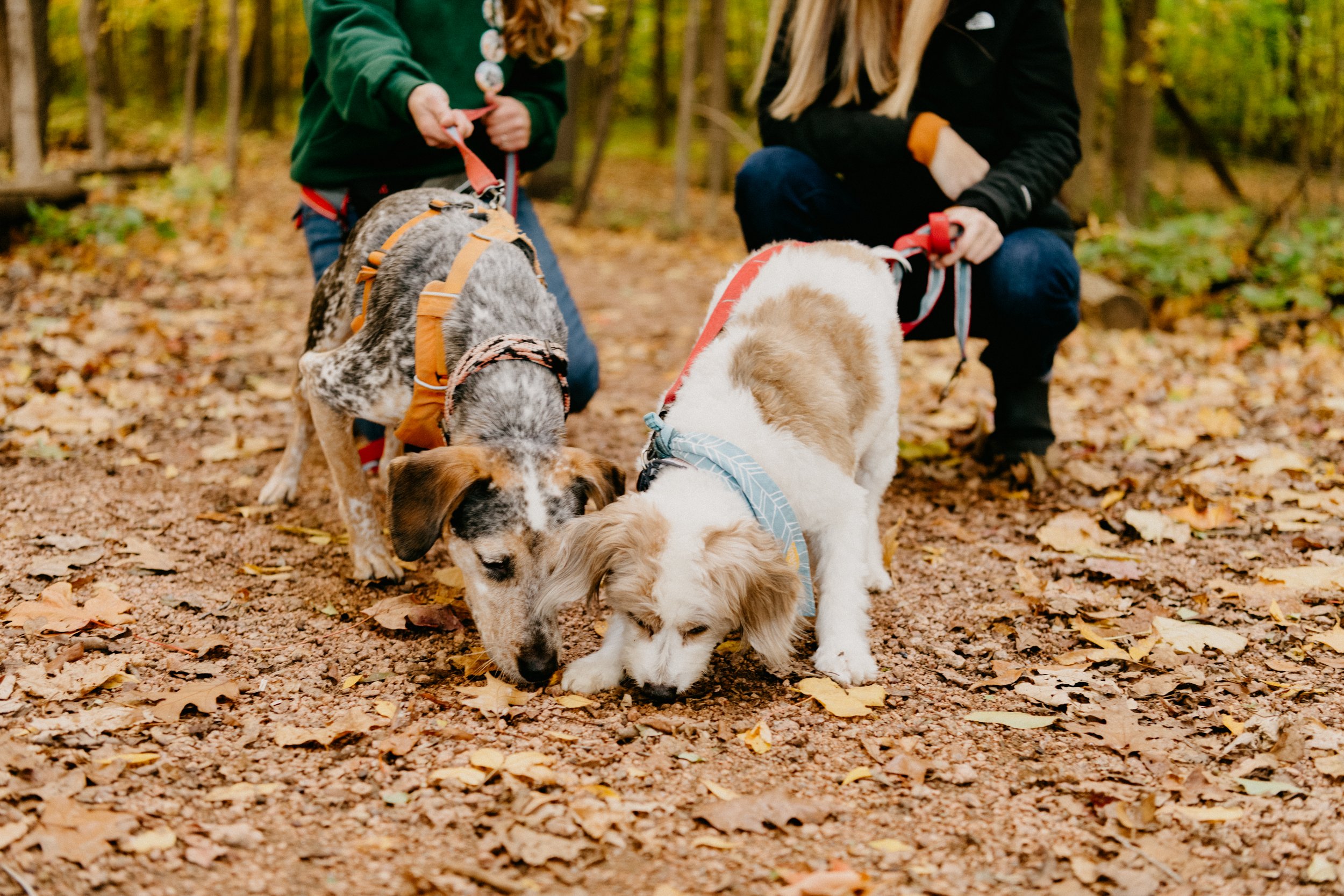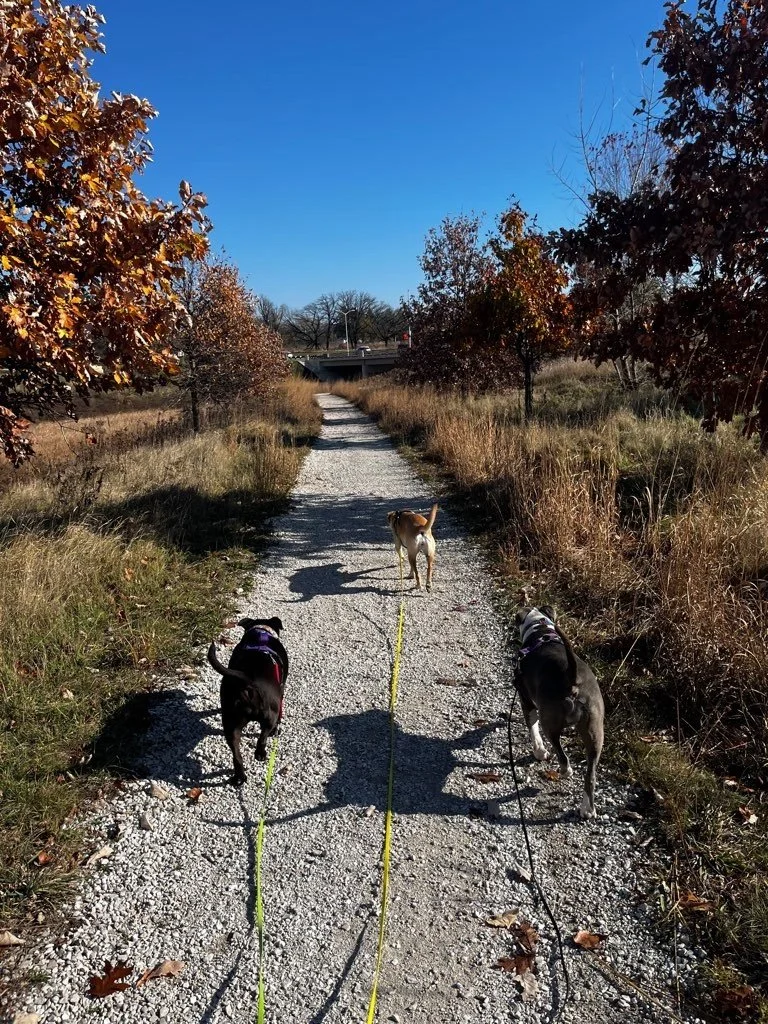Taking your dog for a walk is a great way to bond with your furry friend and provide them with exercise and mental stimulation. However, it's important to be prepared and know how to handle different situations that may arise during your walks. This guide covers everything from choosing the right leash to dealing with unexpected encounters, so you can enjoy stress-free walks with your dog.
Choosing the Right Gear
Choosing the right leash, collar & harness is essential for a safe and comfortable walk with your dog. The leash should be strong enough to handle your dog's weight and size, but not too heavy that it becomes a burden for you to carry. The collar should fit snugly but not too tight, and should not be able to slip off your dog's head, we recommend a martingale collar. A martingale collar is a type of collar that is designed to gently tighten when a dog pulls but will not tighten to the point of choking or causing discomfort. This type of collar is particularly useful for dogs who have a tendency to slip out of traditional flat collars, as it provides an additional level of security without causing harm to the dog. Martingale collars can also be effective for training dogs who tend to pull on their leash, as they provide a gentle reminder to the dog to walk calmly without causing injury. However, it is important to note that while martingale collars can be a safer option for certain dogs, they should not be used as a replacement for proper training and should always be used under supervision to ensure that the collar is fitted correctly and is not causing any discomfort to the dog.
A Harness
Using a harness is generally considered a safer choice for dogs on walks compared to a collar. Collars can put pressure on a dog's neck and throat, which can cause injury or discomfort, especially if the dog pulls or lunges. In contrast, a harness distributes the pressure evenly across a dog's chest and back, reducing the likelihood of injury and making it easier to control the dog. Harnesses are also useful for dogs with respiratory issues, as they reduce pressure on the airway, and for small dogs, who may be more vulnerable to injury from pulling on a collar. Overall, a harness is a safer and more comfortable option for dogs during walks and can help owners better control their pets, making it a worthwhile investment for any dog owner.
The Leash
There are several types of leashes available for dog walking, each with its own benefits and drawbacks. The most common type is the traditional flat leash, which is a simple strip of fabric or leather with a clip at one end for attaching to a collar or harness. Flat leashes are lightweight and easy to use but can be uncomfortable for dogs who pull or lunge, and they offer less control compared to other types of leashes. Another popular option is a retractable leash, which allows the dog to roam farther away from the owner while still being connected to the leash. Retractable leashes can give dogs more freedom to explore but can be dangerous in certain situations, such as in high-traffic areas or when encountering other dogs or animals. A third option is a chain leash, which is more durable and can withstand the pulling of stronger dogs but can be heavy and uncomfortable to hold for extended periods. There are also hands-free leashes available, which allow the owner to attach the leash around their waist or shoulder, freeing up their hands for other activities. Hands-free leashes can be convenient for jogging or hiking with dogs but may require additional training to use safely. Ultimately, the choice of leash depends on the individual needs of the dog and the owner's preference, but it is important to choose a leash that provides adequate control and is comfortable for both the dog and the owner.
The Long Lead
A long lead is a type of leash that is typically longer than the standard 6-foot leash, allowing dogs more freedom to roam and explore during walks. There are several benefits to using a long lead, including providing more exercise for dogs by allowing them to run and play, as well as allowing them to explore their environment more freely. Long leads can also be useful for training purposes, as they allow owners to give dogs more distance while still maintaining control, which can help to build confidence and reduce anxiety in dogs. Additionally, long leads can be useful for owners who have dogs that tend to pull or who are easily distracted, as they allow owners to give more space while still maintaining control over the dog's movements. Finally, long leads can be useful for owners who have dogs with limited mobility or who are recovering from injury or surgery, as they provide a safe and secure way for the dog to move around and exercise without putting undue strain on their joints or muscles. Overall, long leads offer a range of benefits that can help dogs to stay active and engaged while still providing the necessary level of control for their owners.
Understanding Your Dog's Behavior and Body Language.
Understanding your dog's behavior and body language is crucial for a successful and safe walk. Dogs communicate through their body language, and it's important to be able to read their signals to avoid any potential conflicts or accidents. For example, a dog that is wagging its tail doesn't always mean it's happy - it could also be a sign of anxiety or aggression. Similarly, a dog that is growling or barking may be trying to communicate that it's uncomfortable or scared. By learning to read your dog's body language, you can better understand their needs and ensure a positive walking experience for both you and your furry friend.
Planning Your Route and Staying Safe.
Before heading out on a walk with your dog, it's important to plan your route and take safety precautions. Choose a route that is safe and free from potential hazards, such as busy roads or aggressive dogs. Make sure your dog is wearing a collar with identification tags and is up-to-date on vaccinations. Bring along a first aid kit and plenty of water for both you and your dog. It's also a good idea to let someone know where you're going and when you expect to return, in case of an emergency. By taking these steps, you can ensure a safe and enjoyable walk for you and your furry friend.
Dealing with Common Challenges, such as Pulling and Barking.
While dog walking can be a fun and rewarding experience, it can also come with its fair share of challenges. One of the most common challenges is dealing with a dog that pulls on the leash or barks excessively. To address pulling, consider using a front-clip harness or a head collar to give you more control over your dog's movements. To address barking, try to identify the trigger and redirect your dog's attention with a toy or treat. Consistent training and positive reinforcement can also help address these challenges over time.
Preparing for Emergencies and Unexpected Situations.
As a responsible dog owner, it's important to be prepared for emergencies and unexpected situations while out on a walk. Always carry a first aid kit, including items like bandages, antiseptic wipes, and tweezers for removing ticks or splinters. It's also a good idea to have a plan in place for what to do if your dog becomes injured or lost. Make sure your dog is wearing identification tags with your contact information, and consider microchipping them for added security. Finally, be aware of your surroundings and potential hazards, such as aggressive dogs or busy roads, and take steps to avoid them if possible.
Go Forth & Walk!
Overall, walking your dog is a great way to bond with them and keep both of you active. However, it’s important to be prepared for any potential challenges or emergencies that may arise while out on the walk. By understanding your dog's behavior and body language, planning routes ahead of time, dealing with common issues such as pulling and barking using positive reinforcement training methods, and preparing for unexpected situations by carrying a first aid kit and having identification tags attached to their collar; you can ensure safe walks for both you and your furry friend. With these tips in mind, go forth confidently into the world knowing that you are ready to handle whatever comes up!








Dogs use appeasement gestures—subtle body language cues—to diffuse tension, avoid conflict, and express discomfort. Learn how to recognize these signals to better understand your pup’s emotions and strengthen your bond.